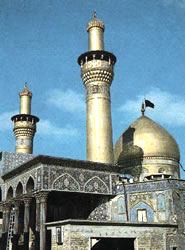 |
Shrine
of Husayn Ibn Ali Karbala, Iraq |
The festival of Ashura* is observed as a day of fasting by both Sunni and Shi’a Muslims, but in different contexts. When the prophet Muhammad and his followers fled to Yathrib (later Madinah) in 622 CE, they encountered a sizeable Jewish community. In those days, the Jewish Day of Atonement occured on ’Ashor, and was observed with a 24-hour fast. It is believed that Muhammad adopted this practice, but when relations became difficult between the two communities, the major Muslim fast was moved to the month of Ramadan.
Nonetheless, devout Muslims still fast on Ashura. The Sunni community use it as an occasion to remember several events, including Nuh (Noah) leaving the Ark, and Allah saving Musa (Moses) from the Egyptians. It is also observed as a day of mourning, most particularly for the Shi’a community.
Shi’a, the only major schism in Islam, has a history nearly as long as the religion itself. According to Shi’ite historians it began shortly after the death of Muhammad, when the Caliphate—the secular leadership of Islam—was passed to the prophet’s father-in-law, Abu Bakr, rather than to ‘Ali, Muhammad’s chosen successor.** In contrast, Western and Sunni historians date Shi’ism to the death of Husayn (680 CE)—son of ‘Ali and Fatima, grandson of Muhammad—in the battle of Karbala on the banks of the river Euphrates.
For the Shi’a community, Ashura is held to be the most significant day of the forty-day mourning period for Husayn. The battle of Karbala is re-enacted and believers hold processions as a communal expression of grief. A striking—and to many, shocking—manifestation of this is the self-flagellation ritual, a blood-letting that is a passionate visual expression of the pain suffered by the faithful at the loss of Imam Husayn.
**The Muslims who supported ‘Ali called themselves the “Partisans of ‘Ali”, Shi’a ‘Ali.